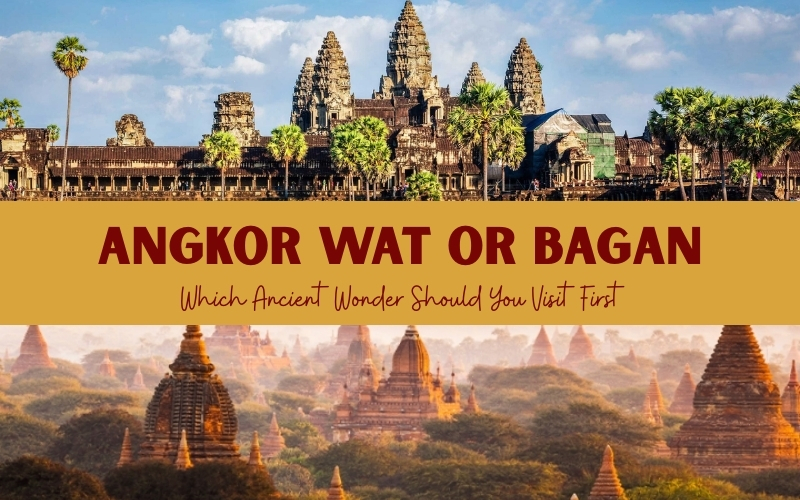
Ever wondered whether to visit Angkor Wat or Bagan first on your Southeast Asia itinerary? Both are awe-inspiring ancient wonders, each with its own story, atmosphere and charm. In this guide, we’ll explore the history, compare your experiences and help you decide which destination deserves a spot on your bucket list – along with practical tips and itinerary suggestions to make your trip memorable.
Overview of Angkor Wat and Bagan
I have been asked many times what the difference is between the temples of Bagan, Myanmar and Siem Reap, Cambodia, and which is more beautiful. I have been fortunate enough to visit both over the years and the short answer is that neither is more beautiful than the other, it depends on personal preference and perspective.
Angkor Wat and Bagan both have their own unique charm and highlights, and are truly awe-inspiring places to visit. Both offer a journey not only through history, but also through the soul of a culture. Angkor is resplendent with its grandeur and precision, Bagan is enchanting with its endless expanse and serene atmosphere. And as someone who has wandered through both, I can tell you – they are experiences that will stay with you long after you leave.
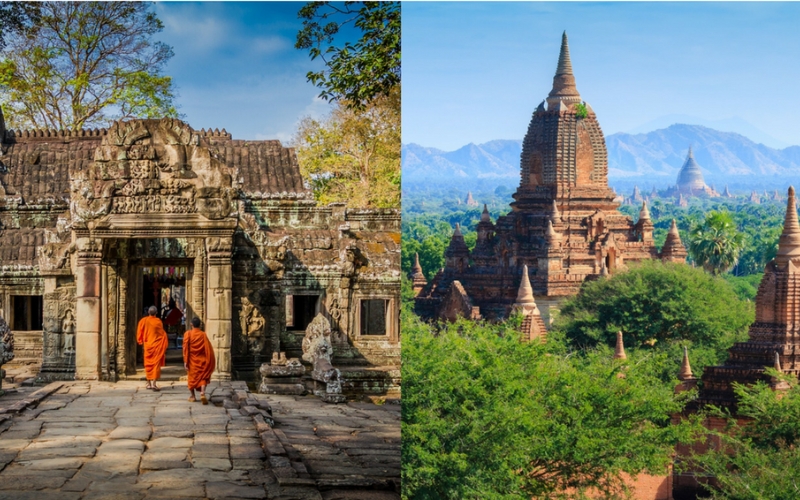
Angkor Wat and Bagan, two timeless wonders of Southeast Asia
Angkor Wat is not simply a complex of Buddhist temples, but it is also one of the wonders of the world, the heart of Cambodia, a very proud symbol of many generations of people in this country. Coming to explore Angkor Wat – the pearl of the Khmer empire, you will be overwhelmed by the splendor and grandeur of this architectural wonder through thousands of ancient Khmer temples with sophisticated motifs and mysterious stone statues.
Bagan is the ancient capital of Myanmar, home to the most unique temple architecture in the world. Bagan currently has about 2,000 temples and towers that have existed for hundreds of years, with various scales and architectural forms looming in the sparse forests. The temples here are often clustered and quite close together, you can choose to walk, bike or leisurely ride a horse on the trails to explore the mossy red brick temples.
Angkor Wat or Bagan? How are they different? A detailed comparison between the two temples
Scale and appearance
When I first stood in front of Angkor Wat, I understood why it is often called the world’s largest religious monument. You will feel so small, the main temples such as Angkor Thom, Ta Prohm, … are just a tiny part of the 400 km2 Angkor Archaeological Park. The central towers, reflected in the lotus-filled moat, rise with symmetry and presence that is almost unreal. Cycling or tuk-tuking between monuments such as Bayon, with its smiling stone faces, or the root-covered Ta Prohm temple, gives the feeling of walking through chapters of an epic story. Every turn reveals a massive causeway, a towering gate, or a hidden ruin, and countless great structures make the space seem endless.
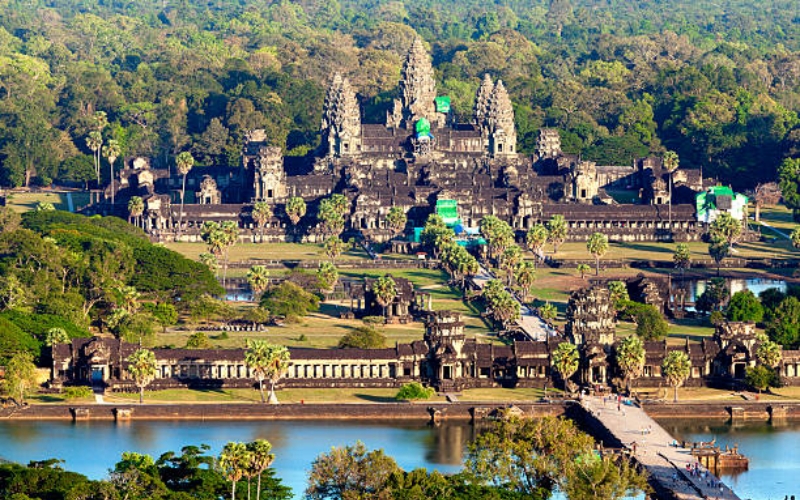
Aerial view of Angkor Wat’s grand temple complex
Bagan, on the other hand, conquers you with its grandeur and stunning panoramas. It is known as one of the most beautiful sunrise spots in the world. I stayed up almost all night to get to the top of the temple on time and the experience was worth it. As dawn breaks, you can see the mist rolling in from the Irrawaddy River, hundreds of temples and stupas emerging from the misty mist, the gilded towers sparkling in the sunlight.
As the mist gradually clears, hot air balloons soar into the sky, creating a famous scene on all social media sites. If the appeal of Angkor comes from the massive scale of each individual site, the magical beauty of Bagan lies in the overall beauty of thousands of architectural works spread across the plain.
Unique architecture
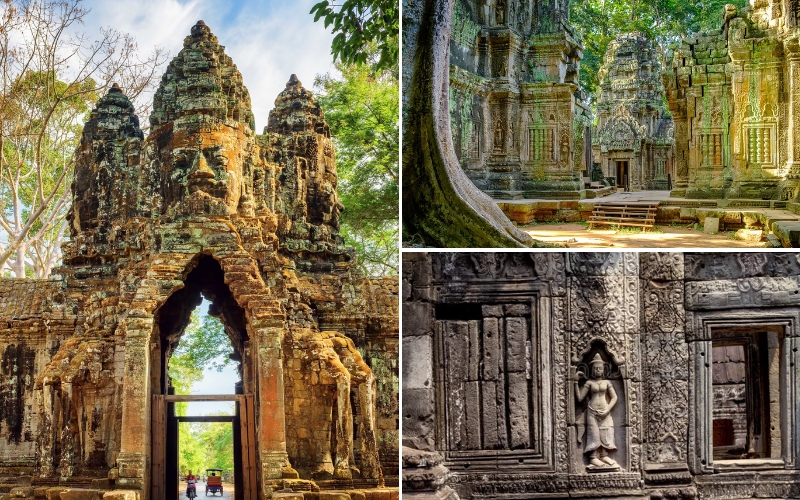
The complex structure of the temples at Angkor Wat
What makes Angkor Wat special is not only its enormous scale but also its unique Khmer architecture and sophisticated sculptures. The harmonious combination of massive scale, balanced layout and meticulous decorative details has created a unique architectural masterpiece. The architecture of Angkor Wat temple is modeled after the great Meru mountain of India, the highest central tower is 65m high symbolizing the legendary Meru mountain, the 5 surrounding towers correspond to the 5 mountain peaks. The entire structure is built of sandstone and honeycomb stone.
Up to now, people still have not figured out how Angkor Wat was built. The towers, temples, reliefs and immense corridors are all made of stone blocks, stacked on top of each other in a very natural way, even on the dome roof without any adhesive. The walls of Angkor Wat are covered with thousands of exquisitely carved reliefs, depicting the epic stories of Ramayana and Mahabharata, Hindu gods, scenes of daily life and especially the image of graceful Apsara dancers. The craftsmanship is so exquisite that even after centuries of weathering, the details are still sharp, demonstrating the talent of ancient artisans.
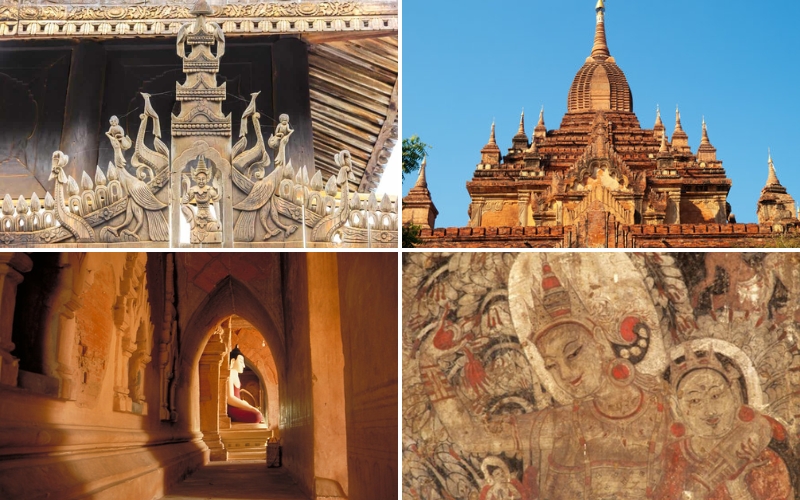
Bagan architecture is influenced by many countries
Unlike the Khmer-inspired architecture of Angkor Wat, Bagan is a Burmese Buddhist temple-style structure, influenced by India and other Southeast Asian countries. Here, the temples are built primarily of baked bricks and reinforced with sandstone. Step inside and you’ll find faded but hauntingly beautiful frescoes telling stories of the Buddha’s life, in soft hues that glow in the subtle light. What makes Bagan’s architecture so appealing is its diversity – no two temples are exactly alike. Some are massive, with tiered steps and towering stupas; others are tiny shrines, barely big enough to hold a seated Buddha statue.
Popularity and crowd level
Angkor Wat is one of the most famous wonders of the world, and therefore attracts a lot of visitors at any time. On my first visit, I remember arriving just before sunrise, thinking I would be almost alone in the temple. Instead, I found hundreds of tourists gathered around the lotus pond, cameras and phones at the ready. Especially from around 8am, the atmosphere became more vibrant, feeling like I was participating in a multi-cultural festival. The trick is to stay off the main paths, try to explore a quieter corridor or go to a less-known temple that often gives you a moment of peace.
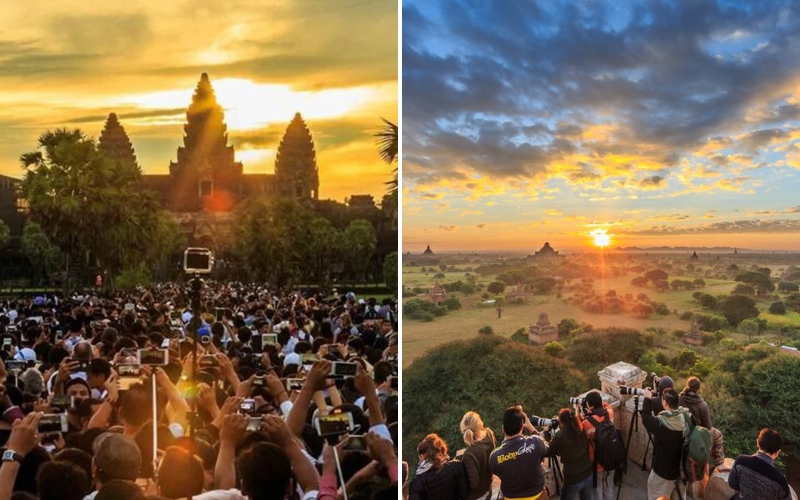
Contrast in visitor numbers: Angkor Wat vs. Bagan at sunrise
Bagan, on the other hand, feels more tranquil, seemingly separated from the hustle and bustle of life. Even in high season, the temples are spread out over such a vast plain that you rarely feel crowded by other tourists. I spent the morning wandering the dirt roads on my bicycle, passing farmers tending their fields and barefoot monks walking between stupas, without seeing another tourist for half an hour. The atmosphere is quiet, almost meditative.
As dusk falls, there may be a bit more tourists, mostly to watch the sunset from the top of the stupas, all quietly watching the sun sink behind the sea of temples. It is this sense of spaciousness and slow pace that makes Bagan feel so private, as if you are exploring on your own.
Accessibility & travel logistics
One of the first things I consider when planning a trip is how easy it is to get there, and here Angkor Wat and Bagan are completely different in terms of accessibility.
Getting to Angkor Wat is incredibly simple. The site is located in Siem Reap, one of Cambodia’s main cities, and is easily accessible by plane with direct flights from major hubs such as Bangkok, Singapore, and Ho Chi Minh City. Once I landed, it took me less than 30 minutes to clear immigration, collect my luggage, and make my way to my hotel. From the town center, the temples are only a 15–20 minute tuk-tuk ride away, and the roads are flat and not too congested even on weekends.
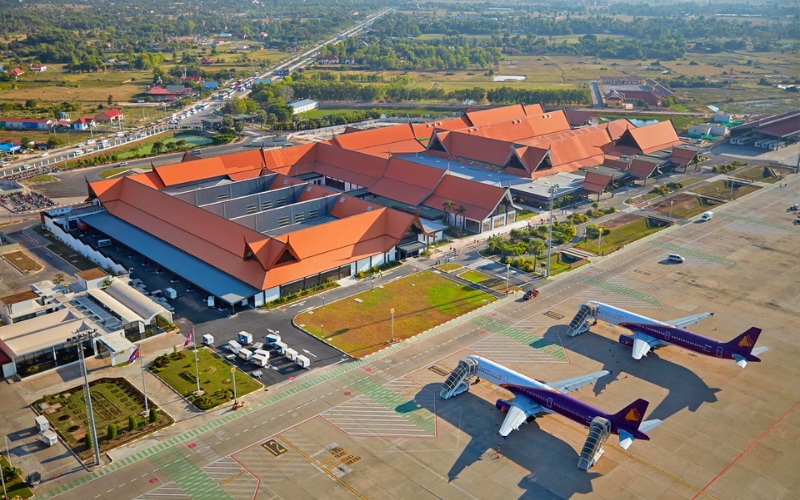
Easy access to Angkor Wat via Siem Reap Airport
Getting to Bagan, on the other hand, is a bit more complicated. There is no international airport here, so you will need to book a domestic flight from Yangon or Mandalay, or take an overnight bus or train, which is cheaper but takes longer (around 4 hours) and can drain your energy before you can explore. I took a short flight from Mandalay, then drove for about 20 minutes to Bagan. Along the way you will see the silhouettes of the temples gradually appearing on the horizon, a moment that still gives me chills.
Getting around is different too. In Angkor, tuk-tuks, bicycles, and even cars are all plentiful. You can explore a lot of the sites at your own pace, with paved roads connecting all the major attractions. But for those who like to conquer, Bagan offers a more free-spirited feeling. You can rent a bicycle and wander the dusty roads between the temples, freely exploring hidden corners that few people know.
> > > If you’re looking for a more active and immersive way to experience the temples and surrounding countryside, our Cambodia 5 Days Discovery by Bicycle tour lets you explore Angkor’s wonders at your own pace, pedaling through quiet village roads, lush rice fields, and hidden temple paths far from the crowds.
Best time to visit
If you want to see Angkor Wat and Bagan at their best, plan your trip during the dry season, from November to March. This time of year is cooler and the sun is soft, the sky is almost always clear, making every photo look like a postcard. In Angkor, the early mornings are dreamy, with the sun rising, the mist rising, and the temple reflections in the lotus ponds crisp, against the honey- and bronze-hued sandstone. In Bagan, the dry season is perfect for sunrise ballooning, where you float over a sea of temples covered in morning mist.
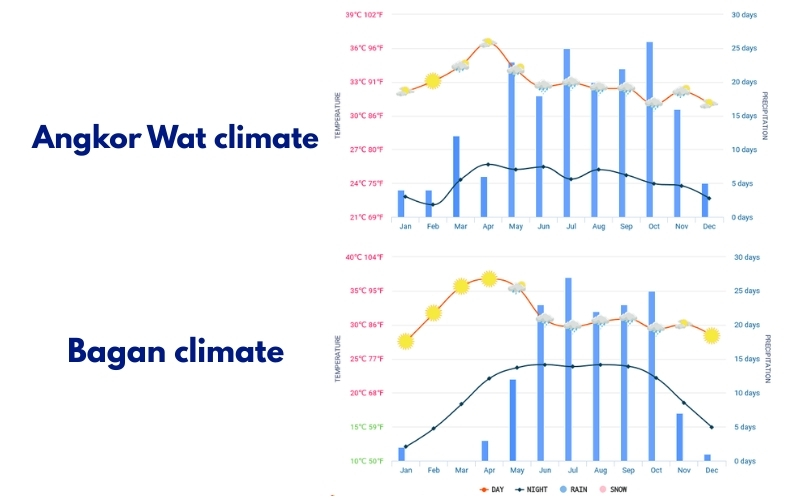
The climate charts of Angkor Wat and Bagan
However, if you don’t want the crowds or can’t arrange a schedule, try exploring during the rainy season, from April to October, which is sure to bring a completely different experience. Although you will have to avoid a few afternoon showers, the rewards are worth it. The rain brings a lush, vibrant green to the landscape, and the crowds thin out. The sunset is especially spectacular after the rain, with the horizon glowing red and the smell of rain still lingering in the air.
Which should you choose first?
I’ve been lucky enough to experience both of these fascinating destinations, and I can tell you – choosing between the two is not easy. Both are memorable, but the experience you get depends on what you’re looking for.
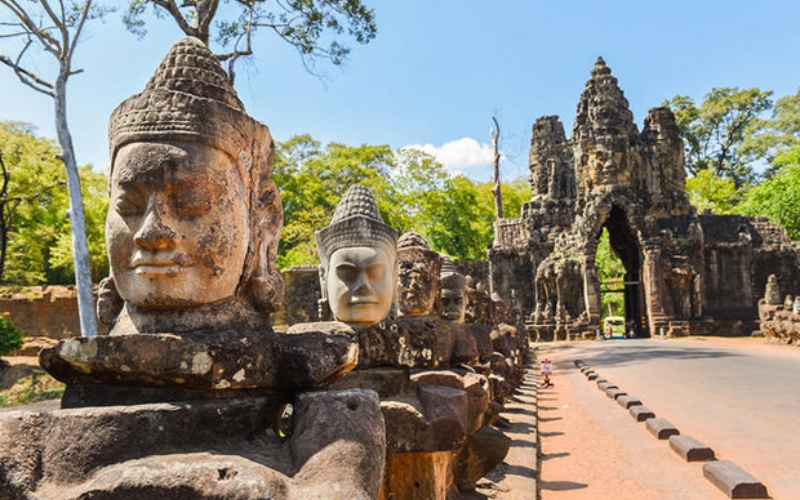
Smiling stone faces at the entrance of Bayon Temple, Angkor Wat
Angkor Wat captivates visitors with its grandeur, intricate carvings, and rich history. Standing before the lotus-shaped towers as the sky turns pink is a magical moment that will stay with you forever. Outside the main temple, you can wander past the mysterious faces of Bayon, get lost in the root-covered ruins of Ta Prohm, or cycle between the ancient tree-lined temple gates. Everything is close by, with easy access to accommodation and transportation, and Siem Reap’s bustling cafes and markets to explore alongside the temples. This combination will surely give you the most complete and comfortable trip.
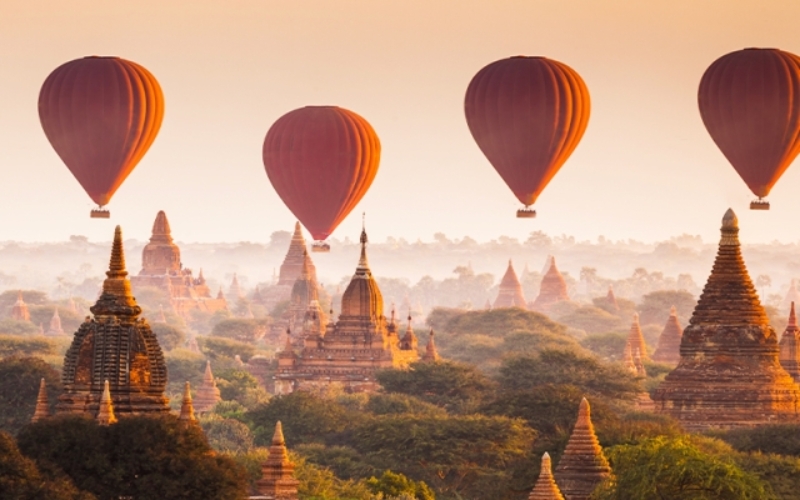
Balloon ride over Bagan’s sunrise
But if you are looking for a deeper experience, tranquility and a little romance in your trip, Bagan could be the perfect choice for you. The temples here are not as intricately carved as those at Angkor, but the sheer number and variety of them – stupas, temples, monasteries – create an impressive skyline that seems like something out of a fairy tale. At dawn, as the hot air balloon gradually rises, you will see the mist drifting off the Irrawaddy River and the Shwezigon Pagoda shimmering in the sunlight. Bagan is peaceful and authentic, perfect for a unique trip where you can really imagine the past.
If you are still wondering which destination to choose, why not try both, each will give you a different experience than any other destination in the world. My advice is to start with Angkor because of its scale and accessibility, then let Bagan sweep you away when you’re ready for something more quiet and peaceful.
Suggested itineraries for visiting Angkor Wat and Bagan
If you’re feeling inspired to explore these wonders for yourself, I’ve handpicked a few tours that blend the must-see highlights with hidden gems so you can experience Angkor Wat or Bagan (or both!) in the most memorable way possible.
10 Days Myanmar Tour Along The Irrawaddy River
Day 1: Arrival in Yangon
Day 2: Yangon – Pyay
Day 3: Full day explore Pyay
Day 4: Pyay – Magway
Day 5: Magway – Pwint Phyu – Minbu – Magway
Day 6: Magway – Bagan
Day 7: Full day explore Bagan
Day 8: Bagan – Mandalay
Day 9: Mandalay – Mingun
Day 10: Depart Mandalay
For a more detailed itinerary, please check this link here.
Angkor Mystery In 10 Days
Day 1: Arrive in Phnom Penh
Day 2: Phnom Penh city tour
Day 3: Phnom Penh – Phat Sanday Village
Day 4: Phat Sanday Village – Kampong Thom
Day 5: Kampong Thom – Saem
Day 6: Saem – Siem Reap
Day 7: Siem Reap – Visit Preah Khan
Day 8: Siem Reap – Visit Angkor Thom & Angkor Wat
Day 9: Siem Reap – Visit Kbal Spean
Day 10: Siem Reap – Departure
For a more detailed itinerary, please check this link here.
Essential travel tips for exploring Angkor Wat and Bagan like a pro
One thing I learned after visiting both Angkor Wat and Bagan is that preparation makes all the difference. Both sites are huge, and the heat and light can be quite harsh, so planning ahead will make your experience more comfortable and memorable.
- Book tickets in advance: To avoid having to queue for tickets to Angkor Wat, you can easily book tickets in advance through the local government’s online ticketing system, making the process easier and faster. However, keep in mind that Bagan does not accept advance tickets. You will have to buy tickets directly at the entrance checkpoints, but don’t worry because the queues are not as long as Angkor.
- Types of tickets to know: At Angkor Wat, there are 3 types of tickets based on time: 1 day, 3 days and 7 days. If it’s your first time here, I recommend getting a 3-day pass to explore, which is enough time to comfortably visit the famous temples and lesser-known sites without rushing. Avoid buying a one-day pass as I swear you won’t get to experience the whole site and it will leave you feeling tired and overwhelmed. Bagan’s system is simpler: you only pay the Archaeological Zone Fee once for your entire stay. I always keep my pass in my backpack as it is sometimes checked at smaller temples, not just the famous ones.
- Dress comfortably and modestly: both destinations are places of great spiritual and historical importance, not just photo ops. Wear modest, comfortable clothing that is easy to move in, such as light linen pants, loose cotton shirts and walking shoes as you will be doing a lot of walking. I’ve seen people struggling with lace-up boots in 35°C heat, just to get a good photo, which is not an option.
- Start exploring early: early morning at sunrise is always the best time to visit both temples. Seeing Angkor Wat reflected in the lotus pond as the sky turns pink, or watching the colorful hot air balloons hovering over the towers in the mist is definitely an experience any visitor would want. But leave before 11am as the temperature can be quite high and the sun is strong. You can stop for lunch, rest at a cafe and come back in the afternoon when it’s a little cooler.
- Choose the right means of transport: In Angkor, the distance between the main temples is quite far. I took a tuk tuk to get there (you’ll chat with friendly locals and maybe learn some unique information about the destination) and a bike to explore nearby sites in the central area. In Bagan, rent an e-bike, they’re cheap and easy to use, but make sure the battery is full before you go.
- Don’t just visit the famous temples: First-timers often rush from one famous site to the next, but some of my best memories come from the smaller, quieter temples where no one else is around. In Angkor, I loved wandering through the mossy corridors of Preah Khan; in Bagan, climbing up a small, unnamed temple to watch the sunset felt like having the whole plain to yourself.
I hope this article has helped you gain a better understanding of what makes Angkor Wat and Bagan so special, and which might be the perfect first stop on your itinerary. Both promise breathtaking beauty, rich history, and unforgettable moments – whichever you choose, you’ll be entering a world where the past comes alive before your eyes. If you’re ready to start planning your adventure, contact us today. Our team can help you choose the right itinerary, organize every detail, and ensure your trip is as smooth and memorable as possible. Your journey to one of these ancient wonders starts here.
Read more:



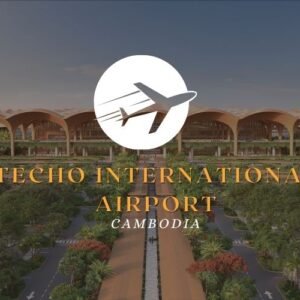
I stood there at dawn, freezing and half asleep, watching people crowd the lotus pond while my coffee went cold in my hand. The towers slowly lit up and for a second I forgot to breathe. Is three days really enough to feel like I’ve seen Angkor properly?
Three days will let you see the highlights without collapsing, but it won’t show you everything. If you want a quieter, deeper experience, stretch it to four or five days and slip in the lesser-known temples between the crowds.